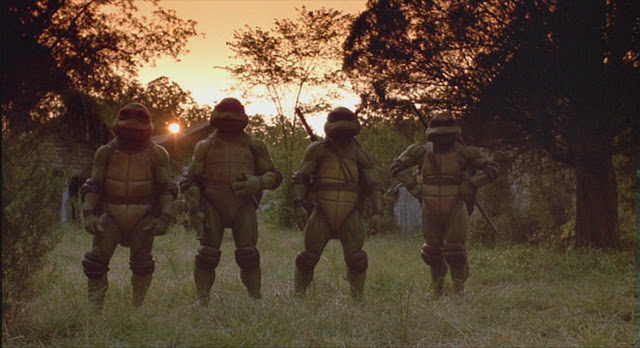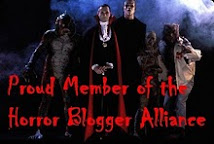When I first heard of The Basement, a "lost" "DIY" (don't worry, if you're new to the place I'll have a glossary coming up soon) horror film shot on Super 8 in the late '80s and unleashed recently in a really cool looking DVD/VHS box set, I expected next to nothing. In fact, I expected something that the more "hardcore" horror fans would laud as the best worst thing ever - kinda like that
Things movie that happened once - and would be stupid and annoying at the same time.
 |
| Like, it'd be annoying enough that people would make this face. |
Speaking of that glossary, I should point out that the designation of the film being "lost" - which is prominent in the advertising of this "retro" classic - is a bit of a deception. The film wasn't lost, it was never released. Per the commentary by director of photography/producer Michael Raso, attempts to sell the film were futile and director Tim O'Rawe gave up on the project, giving the incomplete film to Raso a few months after it was shot. At first glance, it's easy to see why the film was generally ignored, even if other DIY (that's Do It Yourself, of course, meaning that the productions were generally done by a small group on their own) horrors were being picked up at the same time.
 |
| This guy may need to see a dermatologist later. |
The Basement is about as raw as you could expect a film to be, but unlike more surreal horror films (like Things), the idea behind the film is pretty straight forward. The Basement
borrows from is inspired by anthology horror films like those produced by Amicus Pictures in the 1970s, with assists from Stephen King (one character can be seen reading a King book) and George Romero (who is referenced directly in one segment). Four people walk into a basement, meet a ghoulish guy called The Sentinel, and are forced to confess the sins of their futures. Which is kind of ridiculous, considering the future...you know...hasn't happened yet. But The Sentinel don't give a toot, so just saddle up and enjoy the ride.
 |
| How does a human eating demon that lives in a pool wait 30 minutes after eating when he's already in the pool? |
With four future doomed characters, we of course get four segments in the film, which still only runs 69 minutes long. The first follows a rather annoying and particularly unattractive in her '80s bathing suit woman, who happens to have some sort of hose demon in her swimming pool, which she uses to dispose of folks who deserve to die. By "deserve to die", she generally means "annoys her while she is reading her Stephen King book" or "happens to be in her backyard by the pool". This all ends abruptly when a muscly dude with a mullet comes into the story - who also sounds like he has the voice of a whiny
Nick Swardson - which is the first absolutely must see character in the film.
(Oh, by the way, all the voices in the film are dubbed after the fact - possibly in the 2010 remaster, though I'm not sure about that - which provides for plenty of unintentionally hilarious moments. The ridiculous voices we hear - which usually don't match the image or actor on screen - might be the film's biggest redeeming factor.)
 |
| He said I do, for better or undead worse. |
The second segment of the film is the longest, following a teacher (played by a guy named Dennis Driscoll, who seems to be a better - or at least more committed - actor than everyone else around aside from the dubbing) who is haunted by his dead ex-wife and also hates Halloween. This leads to perhaps
the greatest hilariously bad moment in the history of movies, when his undead wife appears to him on Halloween Eve. The exchange, roughly translated, is as follows:
Husband - MY GOD! IT'S YOU! I DON'T BELIEVE IT
Undead Wife - *Sound of really loud gargling/screaming and a spastic motion that looks like the corpse dummy is being electrocuted and or having an epileptic fit*
Undead Wife - Now do you believe?
Husband - OH MY GOD, IT IS YOU!
I'm not exactly sure what the relationship between these two was, but if an epileptic fit is the only way to prove who you are, you might want to work out something else. Trust me though - I've watched this sequence a dozen times already, and it still makes me laugh like a hyena.
This segment also includes a gore-soaked daydream in the teacher's classroom and an increasing amount of demonic creatures - which are actually pretty gruesome - that progresses through Halloween night. Sadly, I'm not sure the teacher learned his lesson. When we see the character after the story, back in the basement with The Sentinel, his first question is "WHEN WILL THIS HAPPEN?" Ummmm...dude? That would be October 31st. You suck at Halloween.
 |
| This guy's Halloween costume is pretty darn good. |
The final two segments don't quite live up to the gore standards of the second part, but they each have their own laughable moments of foolishness. One follows the director of a zombie film who unwisely says "Fuck Romero!" in a graveyard, while the latter has a horror author in his new dream home, which he bought despite the realtor informing him that it has no power and no water and was owned by a guy who killed a bunch of people and disappeared, leaving it abandoned. These segments are marred by some awful lighting and a lot of night time sequences, which makes it impossible to make out what's happening at times. The corny performances and silly gore continue, however, and it all wraps up back in the basement with The Sentinel and a grand scale final scene that uses plenty of stock footage.
 |
| Just pretend he's not holding his eyes shut. They're TOTALLY missing. |
|
|
When it really comes down to it, there's no arguing that The Basement is a good movie. But by golly, I laughed and laughed and laughed, and not always in a bad way. Unlike a lot of modern z-grade indie horror films, there's fun to be had with the plot and the awful performances and low quality images give this production a strange charm. A lot of times I was laughing at the movie - especially when I listened to the producer's commentary and heard some of the serious comments about the film (my favorite was when they said that this movie "started" the indie horror craze, even though they spend part of the commentary talking about
The Dead Next Door, which did the same thing earlier AND got distributed in its own decade) - but there were also some times I felt I was laughing with it. The Basement surprised me by not being a total waste of my time, and I can honestly see myself throwing this one in again for a laugh or two.
This is zero-budget horror, but it's zero budget horror with a plot and no elements that are completely wrong for the film. I've seen others try to make movies like this and fail miserably. By that logic....maybe The Basement is on to something. If you're up for something completely pointless and unintentionally hilarious, it might be the movie for you.

















































